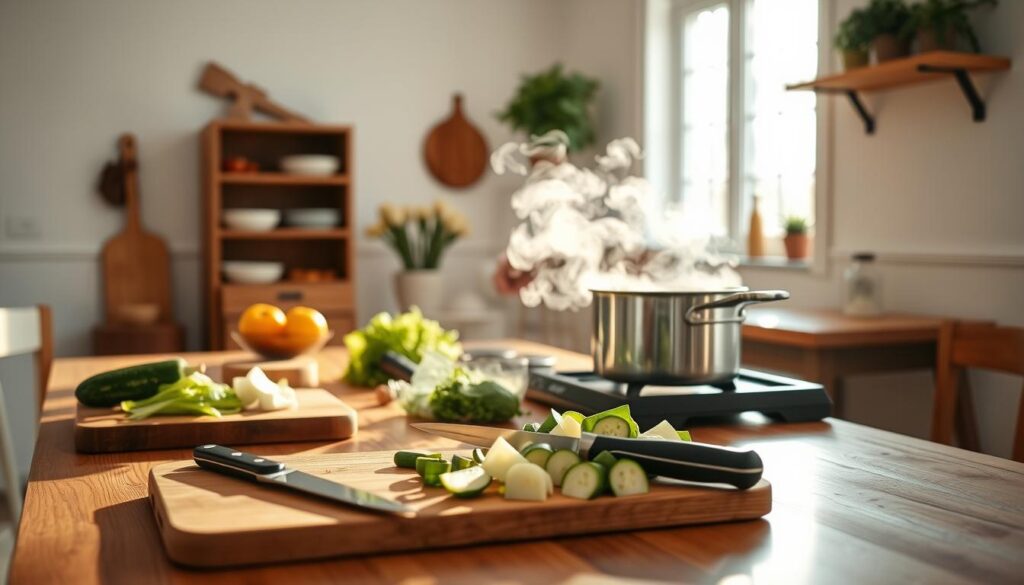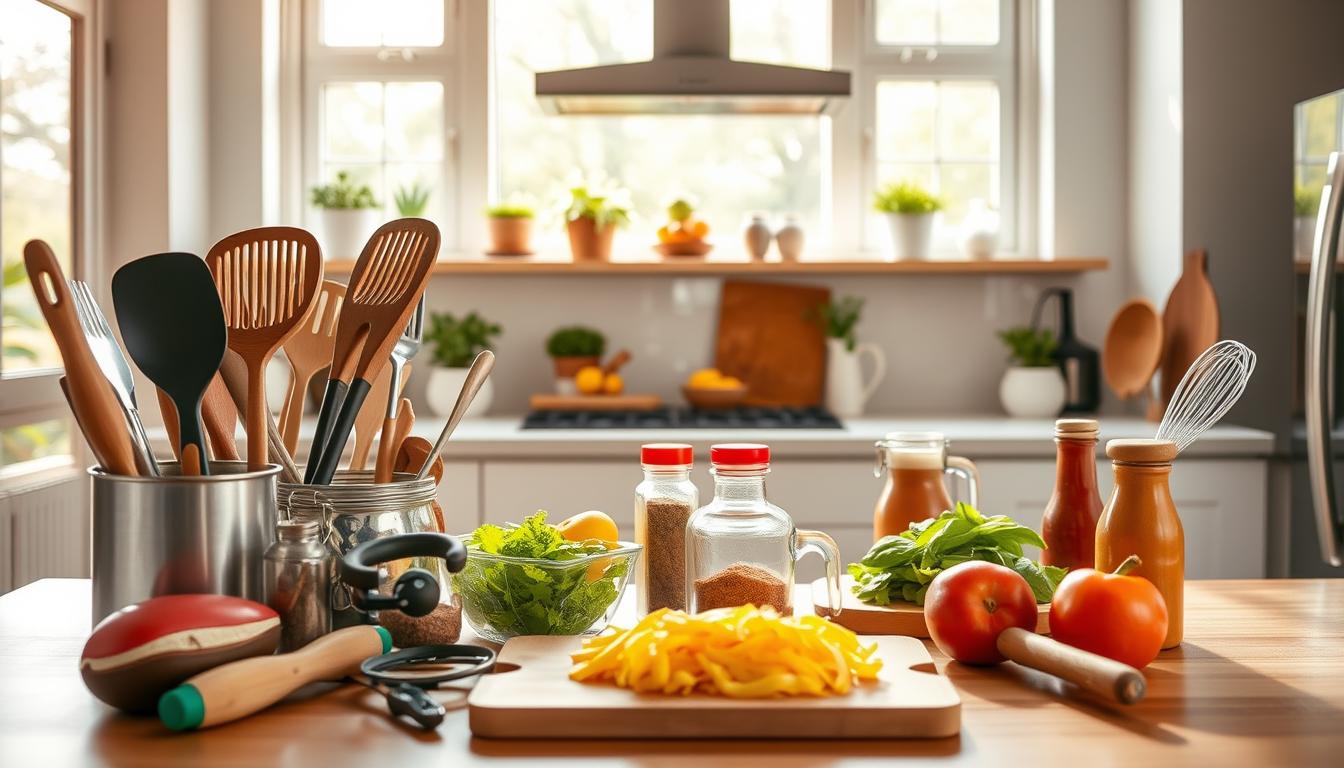We think cooking from scratch is fun and rewarding. With the right kitchen hacks, anyone can become a skilled cook. We’ll share simple and easy-to-follow solutions for delicious dinner recipes. These tips and hacks will make cooking easier for beginners.
Cooking dinner from scratch can save a lot of money. It can cut food costs by 30-50% compared to pre-packaged meals. With these kitchen hacks and tips, you can make tasty meals like shrimp scampi in 2-3 minutes. Or, try salmon with soy and honey glaze in about 10 minutes.
Our goal is to guide you through a culinary journey. We’ll explore kitchen hacks and DIY dinner recipes. By mastering these simple solutions, you can reduce food waste, save time, and make meals your family will love. Plus, you’ll learn essential beginner tips for cooking.
Key Takeaways
- Cooking from scratch can reduce food costs by approximately 30-50% compared to pre-packaged meals.
- Applying kitchen hacks and beginner tips can make cooking easier and more efficient.
- Simple dinner recipes like shrimp scampi and salmon with soy and honey glaze can be prepared in under 15 minutes.
- Cooking dinner recipes from scratch can help reduce food waste and save time.
- Mastering kitchen hacks and beginner tips can help us become confident cooks and create delicious meals for our families.
- Exploring various cooking methods, such as stir-frying and broiling, can help us create a variety of dinner recipes.
Understanding the Basics of Cooking
Easy cooking starts with knowing the basics. Recipes for beginners often use simple methods like sautéing, boiling, and roasting. It’s important to learn basic cooking terms to feel confident in the kitchen.
Start with simple cooking methods. For example, score tomatoes and boil them for 10 minutes to make peeling easier. Soaking spinach and kale in water for 15 minutes can also help remove dirt.
For more challenging dishes, cook meat from room temperature after it rests for 15-20 minutes. This ensures even cooking. Salting eggs 15 minutes before cooking can improve flavor and prevent overcooking. Roast chicken at a minimum of 400°F, but 425°F is best.
Essential Cooking Techniques
- Sautéing: a fundamental technique for cooking vegetables and meat
- Boiling: used for cooking pasta, rice, and vegetables
- Roasting: ideal for cooking chicken, beef, and vegetables in the oven
Learning these basic techniques will help you make tasty, easy meals. Start with beginner-friendly recipes and you’ll soon become a pro in the kitchen.
| Cooking Technique | Description |
|---|---|
| Sautéing | Cooking vegetables and meat in a pan with oil |
| Boiling | Cooking food in boiling water |
| Roasting | Cooking food in the oven using dry heat |
Kitchen Tools Every Novice Needs
Having the right kitchen tools is key to cooking well. The right equipment helps you make tasty meals easily. We’ll cover the essential cooking utensils, cookware, and appliances for beginners. You’ll learn kitchen hacks and DIY dinner hacks to set up your kitchen for success.
A good kitchen starts with basic tools like a chef’s knife, silicone spatula, and cutting board. Measuring cups and wooden spoons are also must-haves. A quality saucepan, cast-iron skillet, and meat thermometer can also boost your cooking. Using these tools and kitchen hacks can save time and make meals healthier and tastier.
Right cookware and appliances also matter. A slow cooker or Instant Pot is great for busy people. It lets you cook big meals easily. With DIY dinner hacks and the right tools, you can make everything from stews to roasted veggies.
Simple Meal Planning Strategies
Exploring cooking means learning simple meal planning. This helps us make tasty and budget-friendly meals. Start by planning your dinners for the week. It’s as easy as picking a recipe for each day.
Creating a grocery list is key. Focus on what you need for your dinner plans. This stops impulse buys and cuts down on waste. Use tools or apps to make planning and shopping easier.
Save money by planning meals with seasonal produce. Buy in bulk and get creative with leftovers. These tips help you enjoy healthy meals without spending too much.
- Involve family members in the meal planning process to ensure everyone’s preferences are considered
- Keep a rotation of 10-15 simple recipes for ease in meal planning and preparation
- Shop regularly to minimize unnecessary purchases and reduce food waste
Follow these strategies and tips to make delicious, affordable dinners. Your family will love them.
Time-Saving Cooking Hacks
Looking for quick and easy meals? We all do. Using time-saving cooking hacks is a smart way to cook fast. These hacks include using tools that do more than one thing and cooking in batches.
One-Pot Meals for Busy Nights
One-pot meals are perfect for quick dinners. They let us cook a whole meal in one pot, saving time and effort. Try making stir-fries, skillet dinners, or soups. Using a high-speed blender or Instant Pot can make cooking even quicker.

Batch Cooking for Easy Weeknight Dinners
Batch cooking is great for saving time. It means making several meals at once. This can cut down meal prep time by 3-5 hours a week. It’s perfect for busy families who want healthy, easy meals.
Flavor Boosting Techniques
Flavor is key in cooking. We can make our meals better by using fresh herbs and spices. We can also improve store-bought sauces. These tips can really change how our DIY dinners taste.
Toasting dry spices brings out their oils and flavor. Adding fresh herbs at the end keeps their taste strong. Using good broth can also make our dishes taste better. We can save bones and scraps to make our own broth.
We can also use tricks to add flavor. A splash of vinegar can brighten up dull dishes. Adding butter to sauces before serving makes them richer and shinier.
- Use fresh herbs and spices to add flavor to meals
- Enhance store-bought sauces with kitchen hacks
- Toast dry spices to release their essential oils
- Add fresh herbs at the end of cooking to retain their flavor potency
By using these techniques, we can make meals that taste amazing. With a bit of practice, we can become experts at making delicious DIY dinners.
| Technique | Description |
|---|---|
| Toasting dry spices | Releases essential oils and enhances flavor |
| Adding fresh herbs | Retains flavor potency and adds freshness |
| Enhancing store-bought sauces | Adds flavor and richness to meals |
Easy Substitutions for Common Ingredients
Having the right ingredients is key in cooking. But, we don’t always have what we need. That’s when substitutions come in. They help us make tasty beginner-friendly recipes for different diets.
We can swap 1 cup of whole milk for soy milk or rice milk. This is perfect for those who can’t have dairy. Also, we can use 1/4 teaspoon baking soda and 1/2 teaspoon cream of tartar instead of 1 teaspoon of baking powder. This works well for those who are gluten-free.
Here are some other common substitutions for our simple dinner ideas:
- 1 cup of salted butter can be replaced with 1 cup of margarine or 7/8 cup of vegetable oil plus 1/2 teaspoon salt
- 1 cup of buttermilk can be substituted with 1 tablespoon of lemon juice or white vinegar plus enough milk to make 1 cup
- 1 egg can be replaced with 3 tablespoons of mayonnaise or 1/4 cup of applesauce
These substitutions let us make a variety of tasty beginner-friendly recipes. They’re great for simple dinner ideas or for trying new things in the kitchen. Substitutions add creativity to our cooking.
| Ingredient | Substitution |
|---|---|
| 1 cup whole milk | 1 cup soy milk or rice milk |
| 1 teaspoon baking powder | 1/4 teaspoon baking soda and 1/2 teaspoon cream of tartar |
| 1 cup salted butter | 1 cup margarine or 7/8 cup vegetable oil plus 1/2 teaspoon salt |
Cooking for Dietary Restrictions
Cooking for dietary restrictions can be tough, but with the right hacks, it’s easier. We can make tasty meals for different needs, like vegetarian and gluten-free options.
When cooking for dietary needs, picking the right ingredients and techniques is key. For instance, vegetarian cooking gets simpler with plant-based proteins like tofu and tempeh. Kitchen hacks like meal prep and batch cooking save time and effort.
Preparing gluten-free meals is simple with gluten-free flours and ingredients. We also need to watch out for cross-contamination. DIY dinner hacks like one-pot meals and slow cooking make prep work easier.
Cooking for allergies means paying close attention to ingredients and labels. We can use hacks like reading labels carefully and asking about ingredients. This way, we can make safe and delicious meals for all, no matter their dietary needs.
Here are some tips for cooking for dietary restrictions:
- Plan meals ahead to have the right ingredients.
- Use kitchen hacks like meal prep and batch cooking to save time.
- Be careful about cross-contamination and use separate tools and surfaces.
Quick and Healthy Snack Ideas
Looking for easy cooking? Quick and healthy snack ideas are key. We often seek simple dinner ideas that can be made fast. Snacking is a big part of our day, and the right snacks can curb our cravings.
Snacks come in many forms, like mixes, dips, mini-meals, and leftovers. For instance, a simple snack mix with nuts like pistachios, almonds, and cashews is full of protein and healthy fats. Easy dips like hummus or ranch pair well with veggies or whole grain crackers.

- Fresh fruits and vegetables with yogurt dip
- Hard-boiled eggs with whole grain crackers
- Trail mix with nuts and dried fruits
These snacks are not only simple to make but also packed with nutrients. Adding these quick and healthy snacks to our daily routine helps us eat balanced and stay healthy.
| Snack Category | Examples |
|---|---|
| Snack Mixes | Nuts, seeds, and dried fruits |
| Dips | Hummus, ranch, and sweet yogurt dip |
| Mini-Meals | Hard-boiled eggs, whole grain crackers, and fresh fruits |
Mastering the Art of Presentation
When it comes to cooking, how your dish looks is just as key as how it tastes. With some kitchen hacks and DIY dinner tricks, anyone can make a meal that wows guests. OTAO Kitchen offered over 500 cooking classes last year, teaching a wide range of cuisines. This helped participants learn to make dishes that look amazing.
Some top tips for presentation include using fresh herbs and garnishes. Also, arrange food in a way that looks good. And don’t forget about color and texture. By following these tips and practicing, home cooks can make meals that look almost too good to eat. Almost.
Here are some more presentation tips:
- Use a variety of colors and textures to add visual interest to the dish
- Pay attention to portion sizes and arrange food in a way that is balanced and harmonious
- Don’t be afraid to get creative and try new things – it’s all part of the fun of cooking and presenting a meal
By mastering presentation, home cooks can elevate their meals. This makes for a memorable dining experience. With practice and patience, anyone can become skilled at presenting delicious and beautiful food.
| Tips for Presentation | Description |
|---|---|
| Use fresh herbs and garnishes | Add a pop of color and freshness to the dish |
| Arrange food in a visually appealing way | Pay attention to balance and harmony |
| Pay attention to color and texture | Use a variety of colors and textures to add visual interest |
Cleaning and Organizing Our Kitchen
As we dive into cooking, a clean kitchen is key. Beginner tips like having a spot for utensils and ingredients help. This makes cooking smoother and lets us enjoy making tasty meals for our loved ones.
Keeping the kitchen tidy is vital. A good system for cleaning dishes and sweeping floors saves time and stress. For example, using a dishwashing liquid for grease and food residue makes cleaning easier. Also, a quality vacuum cleaner keeps floors clean and dust-free.
By following these tips, we can make our kitchen both useful and lovely. Whether we’re cooking or reheating, a clean kitchen is ideal. With practice, we’ll master our kitchen, making delicious meals with ease.
Exploring Global Cuisines
As we explore cooking, we find easy and simple dinner ideas in many global cuisines. From Asian to Italian, each culture brings its own twist to food. This lets us try new flavors and techniques.
Some popular global cuisines include:
- Chinese: known for its stir-fries and noodle dishes
- Indian: famous for its curries and spices
- Italian: loved for its pasta and pizza
By using easy cooking and simple dinner ideas from around the world, we can make tasty meals. Online resources and cooking communities help us find new recipes and techniques. This way, we can improve our cooking skills.
Exploring global cuisines is fun and rewarding, whether cooking for ourselves or others. It lets us connect with different cultures and traditions. Plus, it helps us create lasting memories with our loved ones.
| Cuisine | Popular Dishes |
|---|---|
| Chinese | Kung Pao chicken, dumplings |
| Indian | Chicken tikka masala, naan bread |
| Italian | Pizza, spaghetti Bolognese |
Growing Our Culinary Skills
As we keep cooking, it’s key to look for ways to grow and get better. Whether you’re new to cooking or want to try new things, there are many resources to help. These can make you more confident and skilled in the kitchen.
Explore Online Cooking Tutorials
The internet is full of kitchen hacks and beginner-friendly recipes. Sites like The New York Times Cooking have over 8,000 recipes with great reviews. You can also find DIY dinner hacks on YouTube to learn new tricks and flavors.
Join a Cooking Class
For a hands-on experience, try a local cooking class or workshop. These sessions teach us important skills, like making omelettes or sharpening knives. Learning from experts and cooking with others boosts our confidence and lets us try new dishes.

